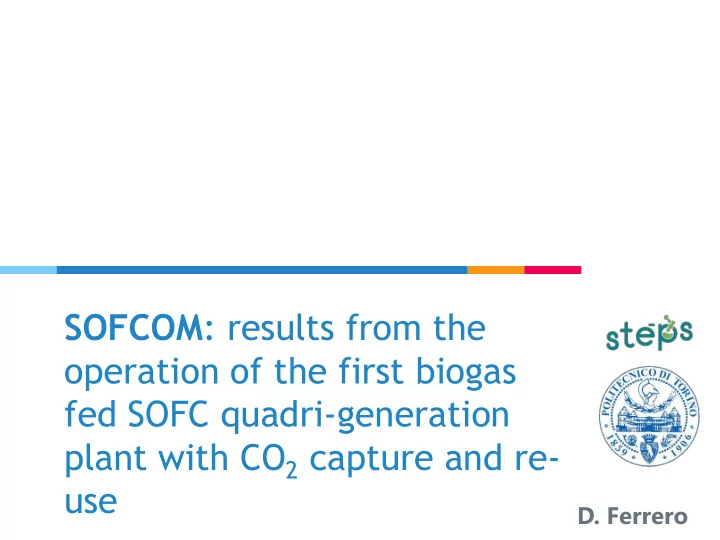

SOFCOM : results from the operation of the first biogas fed SOFC quadri-generation plant with CO 2 capture and re- use D. Ferrero
SOFCOM Project ▷ SOFCOM is an applied research project devoted to demonstrate the technical feasibility, the efficiency and environmental advantages of CHP plants based on SOFC, fed by different typologies of biogenous primary fuels (locally produced), also integrated by a process for the CO2 separation from the anode exhaust gases. ▷ Partnership:
Index Lessons Demo Results learned
1. SOFCOM DEMO PLANT
Plant localization: SMAT Waste Water Treatment Plant
SMAT Waste Water Treatment Plant Water line WASTE WATER Sewerage system
SMAT Waste Water Treatment Plant SLUDGE CLEAN WATER River Po Sludge line BIOGAS WASTE WATER Sewerage system
SOFCOM Demonstration Plant SOFCOM Demonstration plant
WWTP biogas potential in EU WASTEWATER Electrical potential Thermal potential [TWh/year] [TWh/year] 10.224 EU 16.933 North Europe 0.854 0.516 1.652 Germany 2.736 1.292 France 2.140 Italy 2.022 1.221
SOFCOM Demo Layout - 1
SOFCOM Demo Layout - 1 INPUT = BIOGAS OUTPUT = Wel OUTPUT = Φ th OUTPUT = CO2 OUTPUT = Φ th
SOFCOM Demo Layout - 2
SOFCOM Demo Layout - 2 OUTPUT = ALGAE INPUT=CO2 OUTPUT = CLEAN H2O
Biogas Biogas cleaning system 2 vessels in series for sulphur and siloxanes removal (ZnO + AC) AC ZnO 2 parallel lines for continuous operation Clean biogas
Biogas Evaporator Biogas processing H2O system Water evaporator (400-500°C) Steam – Pox reformer (700-800 °C) Reformer Reformate
SOFC Fuel Cell 2 kWe electrical generation 800 °C Cathode Anode IN/OUT IN/OUT SOFC
Oxy-combustion system O2 H2 combustion with pure oxygen T max 1200 °C Oxy-combustor Anode Exhaust
CO 2 separation system CO2 + H2O Water Condenser Dry-point membrane for H2O < 500 ppm Condenser Membrane H2O CO2
Water condenser layout: lab test setup Schematic of the test setup: 1. Steam generator 2. Condenser 3. Condensate drain 4. Compressor unit 5. Gas cooler 6. Fog/Water separator 7. Membrane 8. Purge gas split control 9. Membrane pressure regulation.
Photobioreactor system Active area = 9 sqm Algae CO2 PBR Light Waste Clean Water water
2. RESULTS
Parameter Value Unit Biogas flow rate 8.36 NLPM Air flow rate 150-250 NLPM Biogas inlet pressure 220 mbar Reformer temperature 650-850 °C S/C 2.5 - Anode inlet temp. 750 °C Cathode inlet temp. 650 °C SOFC working temp. 820-850 °C Current 24 A Oxy-combustor temp. < 1200 °C O2% in exhaust 1.1 % Compressor out pressure 8 bar Membrane out water < 500 ppm(v)
Biogas composition
SOFC polarization curve
Continuous Specific Day-night operation 50-100 % OCV operation tests 100%
PBR operation
Algae composition
PBR output Clean water Algae Algae
PBR specific test
3. LESSONS LEARNED
Lessons learned: technology Oxy-combustion step: does not present technical limitations, but it • can be enhanced with some improved management of the plant: (a) operate the SOFC at a higher Fuel Utilization in order to reduce the amount of residual H2 and CO in the anode exhaust; (b) in order to fully oxidize the residual H2 and CO molecules, make use of the O2 recovered from the downstream photo-bio- reactor, coming from the algae photosynthetic reaction (also mixed with residual CO2) H2O separation step: is not problematic from the technical point of • view. A possible solution to reduce the energy cost related to the compression of the mixture before the membrane separator could be to operate the whole process in pressure
Lessons learned: technology PBR: is the most “problematic” component of the chain: • (a) the productivity of the PBR in terms of micro-algae has proven to be satisfactory (maximum cumulated value 18.8 g/m2/day), even though it might be further improved; (b) the energy consumption of the PBR (around 9 W/m2) is too high and should be reduced; (c) the micro-algae tend to stick to the surface of the tubes, and this adhesion has to be reduced as it precludes further microalgae growth; (d) there is the necessity to control the injection of CO2 in the water in order to avoid a too high reduction of the local pH, because an acidic water is detrimental for the grow up of most of the algae; (e) the need to accumulate the CO2 coming from the SOFC plant during the dark periods (ie. algae not growing) in a storage buffer.
Learned from the proof-of- concept • Effectiveness of the micro-algae solution: micro-algae are really a fast growing biomass (weekly peak of 4.18 W/m2 in terms of growing rate) • Carbon impact of the tested solution: the CO2 emissions from the SOFCOM system are 0 kgCO2/kWhel, but only if considering the intermediate buffer able to store the CO2 during the period of null irradiance and if the unexploited CO2 at the PBR outlet is recirculated with the O2 to the oxycombustor • Considerations about the interest and effectiveness of the process in relation to global emissions actions: carbon capture from biogas power plants can contribute to an overall emissions cut of 1.6% of the current CO2-equivalent emissions in EU-28 zone.
Place your screenshot here Website project Visit us on www.sofcom.it
Acknowledgments Special thanks to all the people who made this awesome work possible: ▷ Prof. Massimo Santarelli ▷ Marta Gandiglio ▷ Andrea Lanzini ▷ Davide Papurello ▷ Giuseppe D’Andrea ▷ … and all the research group!
Thanks! Any questions?
Recommend
More recommend